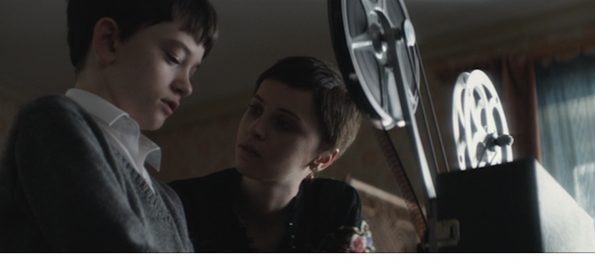3 Screenshots: A Monster Calls
A Monster Calls was my favorite film of 2016, but if failed to earn an Academy Award nomination for Best Picture. A closer look at the film reveals some formal choices that reinforce the story’s themes. While J. A. Bayona’s direction does not draw attention to itself, it does serve the story being told.
One of the first things we are told about Conor O’Malley (Lewis MacDougall) is that he is “too old to be a boy” and “too young to be a man.” Conventional mise-en-scene says that low camera angles tend to make objects look bigger while high camera angles will often make them look smaller and more vulnerable.
It is not a surprise then that the camera shoots Conor from both above and below. In this shot from early in the film the camera tilts up at Conor while his mother stoops. Even though the framing of Conor emphasizes his feelings of entrapment–he gets basically a third of the screen space–his height psychologically emphasizes he is more powerful than the parent who would traditionally take care of him. The lighting is interesting as well. Mom (Felicity Jones) is receding into, but not yet obscured by, the darkness.
Conor’s face is slightly more lit than the rest of his body, symbolically suggesting a spotlight. He is not being actively interrogated by his mother, but the lighting gives a hint as to his emotional state. Conor is being scrutinized by the adults around him, and his secret (revealed at the film’s end) makes him live in fear that he may inadvertently say the wrong thing.
In other scenes, the Camera looks down on Conor, making him look smaller. If Bayona did one or the other, the film wouldn’t capture the volatility of Conor’s situation. At times he is more vulnerable than the average boy; at other times, he is called upon to be more mature than what we would normally require of someone his age.

My favorite shot from the film is an establishing shot at Conor’s school. The camera tracks along the glass behind Conor. Initially he looks backed into a corner. But appearances, like feelings, can be deceiving. As the camera pans, we see Conor does have space in front of him. The reflection in the glass also alerts the attentive viewer that there are parts of scenes that have not yet been revealed to us.
A Monster Calls follows a similar narrative structure. Conor’s situation is established early. Subsequent revelations don’t refute anything we’ve been told, but they remind Conor (and us) that stories can and do change with even the slightest change of perspective. Both Conor’s grandmother (Sigourney Weaver) and father (Toby Kebbell) prove to have more facets than we might expect based on what we know of archetypes from other stories.

Stories, the Monster tells Conor, can contain “painful truths” or “comforting lies.” In one scene, three school bullies maliciously beat Conor, punching him and literally kicking him while he is down. As Conor takes his beating, the camera discreetly recedes around a corner. Such a move can be construed as the film not reveling in the violence, and that is certainly appreciated. But it also, oddly, makes the audience complicit with the school officials who turn a blind eye to Conor’s victimization.
It is not just boys who have trouble facing painful truths; adults, too, prefer stories that are comforting. I’ve heard some criticisms of the film that it is repetitive and predictable, but the inclusion of the bully subplot certainly makes the overall story more complex. We tend to forgive Conor’s act of retaliatory violence (again, like the adults in the film), because we know his “story.” But we are never told the bully’s backstory. Given the Monster’s insistence that people are often not what they appear to be at first glance, it is hard for me to believe this omission is not intentional. The film doesn’t just give us didactic lessons through story; it puts us in a position where we can (or not) apply the lessons that Conor is learning.

